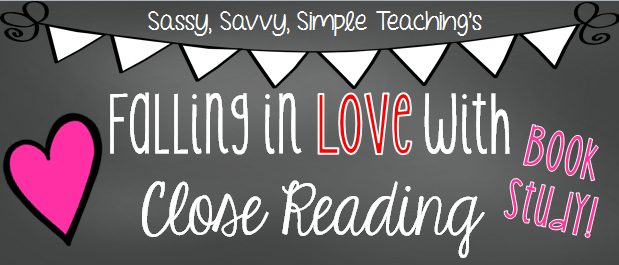"We only get good at the things we do." ~Lehman & Roberts
This statement is a perfect summary thought for chapter 2 of Falling in Love with Close Reading. Chapter 2 is about how to teach students to gather important details in a text, find patterns in those details, and then use those details to make interpretations. The key is modeling these steps and then letting students use the skills they've learned in their own reading.
There is a 3 step process the authors use to teach close reading. Each step helps the students get closer to a deep understanding of the text. Let's start with the first one...
1. Read Through Lenses
At first I had a hard time understanding exactly what the authors meant here, but after reading closely (yep- I just said that-haha) I realized reading through lenses meant identifying what you're focusing on in the text. Some examples might be character, setting, relationships, the central idea etc.
When students know what they're looking for they can better focus their energy.
2. Find Patterns
Okay you've gathered your details now what do they all mean? This step involves looking at the details and seeing if there are patterns or connections. The authors suggest having the students jot down the important details in step 1 and in step 2 to group the details. This can be done with different colored highlighters or circling details that are related. This is also a step where students might get rid of a detail because he/she realizes the detail isn't important.
3. Develop a New Understanding of the Text
In step 3 the reader uses those patterns he/she found to make interpretations about the character, setting, or central idea (whichever topic was the focus). This is also when students should be able to talk or write about the focus, details, and what the details meant. In this step it's important to encourage students to continue using the details from the text and stay away from the "maybe" thoughts. When I refer to "maybe" thoughts I mean those that our students come up with when they use too much of their own ideas & not enough text details. Both details are important for readers to use but we need our students to be able to use text evidence as support to their interpretations.
In non-fiction text this step would involve discussing vocabulary, and using the details to decide on a central idea. Then taking details and new vocabulary to make meaning of the challenging text.
My Interpretation of Chapter Two & An Example
Falling in Love with Close Reading seems to be more geared toward intermediate education however, there is a lot for primary teachers to learn from this book. So as I read I tried to relate it to a book a primary student would be reading. I decided on a Magic Tree House book because the kids love them and these books have enough details to carry a close reading discussion.
In many of the examples they used character as the focus so I'm going to use Magic Tree House: Dinosaurs before Dark as my example to explain what I could do with a group of 2nd graders.
I would have the students focus (step 1) on the main characters Jack & Annie. They could write details (step 2) on a sheet like
this one.
Details About Jack:
Jack worries a lot, he wants to go home, he uses the book to do research, he wears glasses, he takes notes, he's older than Annie, he looks for Annie a lot, he's smart, he gets away from the mean dinosaur, he gets Annie out of trouble with his research.
Details About Annie:
Annie makes Jack get out of the tree house, she's younger than Jack, she isn't afraid of the dinosaurs, she loves animals, she's excited to be in prehistoric times, she wanders off a lot, sometimes she gets into trouble.
After we gathered some details we would (in reading group or whole class) decide which details go together. It was my understanding (from the chapter) that you make generalizations based on the details in this step. So here is one way to group details...
Jack
These could "go together": Jack looks for Annie, and does research, he gets Annie out of trouble.
After putting the details together we could come up with a statement of what we know now.
*These details tell us that Jack is a smart person and a good brother when he does research before going somewhere new to keep himself and Annie safe.
Annie
These could "go together": Annie isn't afraid, she's excited, she wanders off, she makes Jack leave the tree house, and she sometimes gets into trouble.
*These details tell us that Annie is adventurous when she makes Jack enjoy the trip, and goes off on her own unafraid of the dinosaurs.
There are some other interpretations that students could make from the details gathered too. The idea is that the students are using the details to support their interpretations. An activity like this would create a great discussion within your reading group. You could also do this with a read aloud and write details on a chart paper to help younger students read closely.
How would you implement this in your classroom?
Leave a comment below & let's get a discussion going!
























